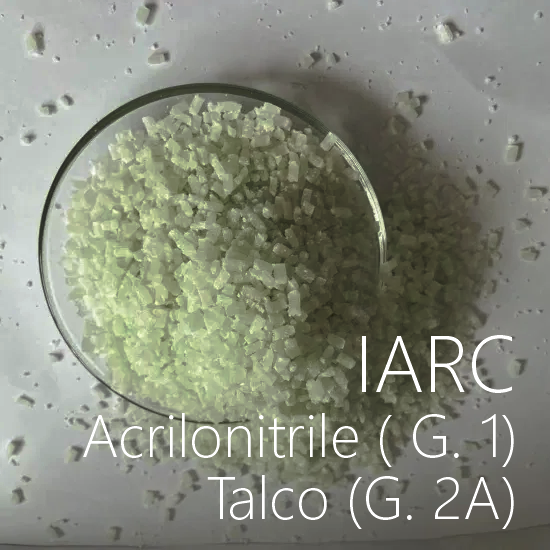IARC Monographs evaluate the carcinogenicity of talc and acrylonitrile / July 2024
| Appunti Chemicals | ||
| 17 Maggio 2025 | ||
| Salve Visitatore | ||
|
IARC ID 22219 | Lyon, France, 5 July 2024 / Download Press release n. 352 of 5 July 2024 The International Agency for Research on Cancer (IARC), the cancer agency of the World Health Organization (WHO), has evaluated the carcinogenicity of talc and acrylonitrile. The outcome of the assessment has been published in a summary article in The Lancet Oncology and will be described in detail in Volume 136 of the IARC Monographs, to be published in 2025. The IARC Monographs programme has previously evaluated talc (2006) and acrylonitrile (1998). Acrylonitrile (Group 1) Acrylonitrile is a volatile organic compound that is mainly used in the production of polymers. These include polyacrylonitrile, styrene–acrylonitrile, acrylonitrile butadiene styrene, and other synthetic rubbers such as acrylonitrile butadiene. Uses of these polymers include fibres for clothing, carpets, and other textiles, as well as plastics for consumer products, automotive parts, and construction. Exposure to acrylonitrile Occupational exposure may occur during the production of acrylonitrile and its use in polymer production. Acrylonitrile is present in cigarette smoke. The general population is exposed to acrylonitrile mainly via inhalation of cigarette smoke (including second-hand smoke). Another source of exposure is air pollution. Several acrylonitrile metabolites and adducts have been measured as biomarkers of exposure to acrylonitrile. Results of the evaluation of acrylonitrile The Working Group classified acrylonitrile as carcinogenic to humans (Group 1) on the basis of sufficient evidence for cancer in humans for lung cancer. There was also limited evidence in humans for bladder cancer. The evidence was mainly from studies in workers producing or using acrylonitrile. In addition, there was sufficient evidence for cancer in experimental animals and strong mechanistic evidence of key characteristics of carcinogens in experimental systems. Strength-of-evidence determinations for acrylonitrile Classification in Group 1 indicates the highest level of certainty that a substance can cause cancer. Talc (Group 2A) Talc, a naturally occurring mineral, is mined in many regions worldwide. Exposure to talc occurs in occupational settings during the mining and milling or processing of talc, or during the production of talc-containing products. General population exposure through the use of talc-containing cosmetics and body powders is best documented; however, exposure through food, drugs, and other consumer products is likely, although less well documented. Because of the challenges of accurate measurement, contamination of talc with asbestos may still be a concern and may lead to exposure of workers and the general population to asbestos (e.g. via contaminated talc-based make-up and body powder). Results of the evaluation of talc After thoroughly reviewing the available scientific literature, the Working Group of 29 international experts classified talc as probably carcinogenic to humans (Group 2A) on the basis of a combination of limited evidence for cancer in humans (for ovarian cancer), sufficient evidence for cancer in experimental animals, and strong mechanistic evidence that talc exhibits key characteristics of carcinogens in human primary cells and experimental systems. Strength-of-evidence determinations for talc The Group 2A classification is the second highest level of certainty that a substance can cause cancer. The full scientific assessment will be published as Volume 136 of the IARC Monographs. add attached Collegati |
||
 |
||
|
è un sito di INVIO NEWSLETTTER Se vuoi cancellarti dall'invio della newsletter oppure effettua il login al sito ed entra nella Tua Area Riservata, in “Modifica dati” agisci con la spunta sul box di selezione “Newsletter”. L'Elenco completo di tutte le ns newsletter è qui: Archivio newsletter |
||
  |
||
| Certifico Srl 2000-2025 | VAT IT02442650541 | ||


































